Alaska
Day 4 - Sunday, 9 September 2001
Our ship was near the northern end of Tarr Inlet in Glacier Bay National Park when we headed up to the deck about 6:30 AM. The sun was just beginning to hit the peaks of the Fairweather Mountains to our west.
The Margerie and Grand Pacific Glaciers were the first glaciers we got to see close up. We drifted near the glaciers for more than 30 minutes.
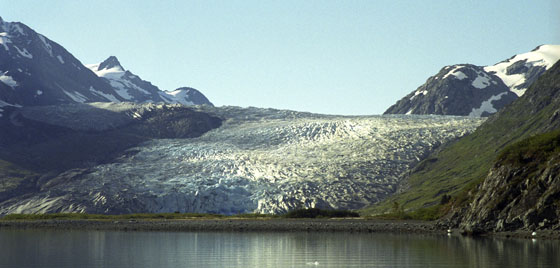 We were surrounded by glaciers. This is the Reid Glacier.
We were surrounded by glaciers. This is the Reid Glacier.
The Grand Pacific glacier is dirty and not very interesting but right next door is the beautiful Margerie glacier. We were lucky enough to be there when a fairly large chunk of the ice calved into the water.
After breakfast we started moving back down the bay, stopping to visit the Lampaugh and Reid glaciers.
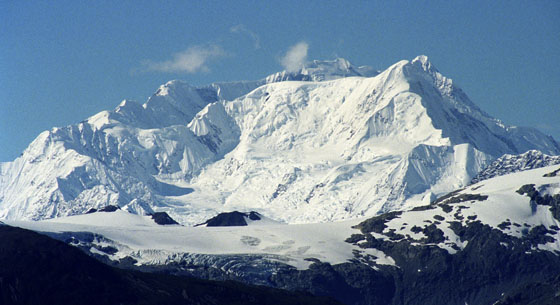 What is more glorious than a snow covered mountain?
What is more glorious than a snow covered mountain?
Wolves and Mountain Goats in Tidal Inlet
About half way down the bay we cruised up Tidal Inlet where we watched three wolves wandering along the hillside above us. They were too far away to get a good picture but were very visible through our binoculars. One wolf was almost white, another was gray and the third was nearly black.
Earlier we had seen a large, woolly mountain goat resting on a rock about midway up the hillside. It too was too far away to get a good picture with a 300-mm lens.
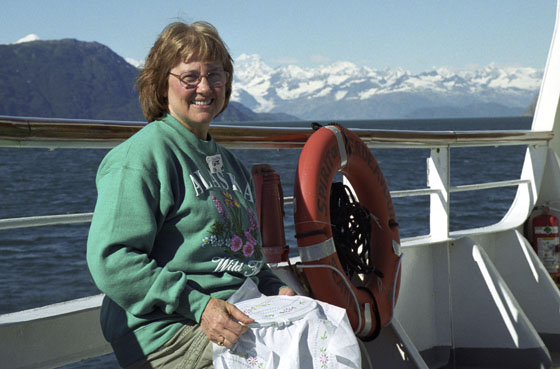 Geri takes a break from her exhausting sightseeing
Geri takes a break from her exhausting sightseeing
Sea Lions
Continuing our cruise down the bay we stopped at South Marble Island after lunch. Here we got to see a large colony of noisy, stinky sea lions. There were also a lot of black legged kittiwakes. Some people claimed they could see two puffins but we never located them.
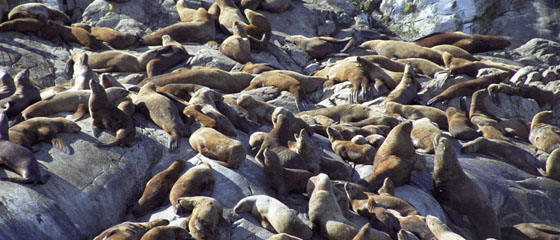 We were close enough to these Sea Lions to smell them. It wasn't pretty.
We were close enough to these Sea Lions to smell them. It wasn't pretty.
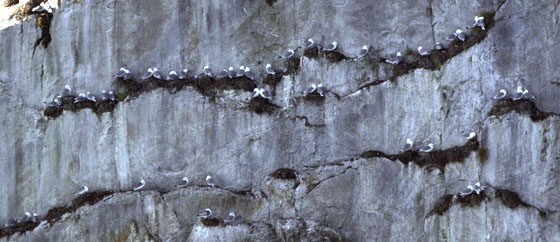 Black-legged Kittiwakes
are the most numerous species of gull in the world.
Black-legged Kittiwakes
are the most numerous species of gull in the world.
We spotted our first whale at about 2:30 PM at N58.600, W136.028. We would see many more humpback whales during the rest of our cruise.
Bartlett Cove
About 4 PM we dropped Paulina off at Barlett Cove, the headquarters of Glacier Bay National Park. Paulina is a park ranger who spent the day on the boat explaining what we were seeing. While in Barlett Cove we saw a sea otter floating on his back. Jim spotted what he thought was a black bear on the shore.
Cruising to Sitka
Leaving Glacier Bay we turned southeast and headed down Icy Strait. About the time we finished dinner we turned south into Chatham Strait. We were sound asleep when the boat turned west into Peril Strait about midnight.
About 3 AM we started down the west side of Baranof Island. Unfortunately we were asleep as we passed through narrow channels winding around islands where lots of eagles nested. We slept through Neva Strait and most of Olga Strait. Fortunately we would retrace our route tomorrow in daylight
Some terms associated with glaciers...
bergy bit: large chunk of glacier ice floating in the sea. Bergy bits are usually less than 5 meters (15 feet) in size and are generally spawned from disintegrating icebergs.
bottom bergs: originate from near the bottom of a glacier. The color is usually black from trapped rock material or dark blue because of old, coarse, bubble-free ice. They sit low in the water due to the weight of the embedded rocks.
chattermarks: striations or marks left on the surface of exposed bedrock caused by the advance and retreat of glacier ice
glacier cave: a cave of ice, usually underneath a glacier and formed by meltwater. Cave entrances are often enlarged near a glacier terminus by warm winds. Most common on stagnant portions of glaciers.
growler: an iceberg less than 2 meters (7 ft) across that floats with less than 1 meter (3 ft) showing above water; smaller than a bergy bit.
ice worm: an oligochaete worm that lives on temperate glaciers or perennial snow. There are several species that range in color from yellowish brown to reddish brown or black. They are usually less than 1 millimeter (.04 in) in diameter and average about 3 millimeters (0. 1 in) long. Some feed off red algae.
For more information on glaciers visit the following web sites: